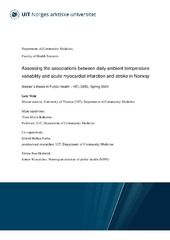Assessing the associations between daily ambient temperature variability and acute myocardial infarction and stroke in Norway
Permanent lenke
https://hdl.handle.net/10037/37174Dato
2024-05-30Type
Master thesisMastergradsoppgave
Forfatter
Wiik, GeirSammendrag
Methods - Retrospective time series analyses with a quasi-Poisson regression model was conducted, using 134,370 incidences of AMI and 127,898 incidences of stroke to estimate the lagged and non-linear associations between DTR and AMI and DTR and stroke in Norway in the years 2008-2018. Subgroup analyses based on age groups were also conducted.
Main results - The findings revealed a significant non-linear association between high DTR and increased risk of AMI, more pronouncedly so among individuals aged 65 and above. The relative risks (RR) of having an AMI were found to be 1.16 (95% CI 1.01-1.33) for the overall population and 1.27 (95% CI 1.06-1.52) for those 65 years and older. These risks are associated with the 99th percentile (15.8 °C) compared to the 50th percentile (6.7 °C) of the DTR distribution. No association was found between DTR and stroke for the overall population or for the population 65 years and older. However, the risk of stroke was reduced centering around the 20 percentile (4.3 0C) with RR=0.86 (95% CI 0.74-0.99) and centering around the 94 percentile (12.9 0C) with RR=0.76 (95% CI 0.62-0.93) for the population younger than 65 years of age.
Conclusion - This study suggests that greater fluctuation in daily temperatures may exacerbate the risk of AMI in a developed, high latitude country like Norway, especially among the elderly population. This is despite Norway’s well-functioning health care system and the DTR being generally less than in larger parts of Europe. These findings underscore the importance of incorporating temperature variability into health planning and risk assessment strategies. Further research is needed to elucidate the mechanisms through which temperature variability affects cardiovascular health and to identify specific population subgroups at greater risk.
Forlag
UiT Norges arktiske universitetUiT The Arctic University of Norway
Metadata
Vis full innførselSamlinger
- Mastergradsoppgaver ISM [209]
Følgende lisensfil er knyttet til denne innførselen:


 English
English norsk
norsk
